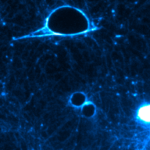Link to Pubmed [PMID] – 24011174
Bioconjug. Chem. 2013 Oct;24(10):1750-9
Clostridial neurotoxins reversibly block neuronal communication for weeks and months. While these proteolytic neurotoxins hold great promise for clinical applications and the investigation of brain function, their paralytic activity at neuromuscular junctions is a stumbling block. To redirect the clostridial activity to neuronal populations other than motor neurons, we used a new self-assembling method to combine the botulinum type A protease with the tetanus binding domain, which natively targets central neurons. The two parts were produced separately and then assembled in a site-specific way using a newly introduced ‘protein stapling’ technology. Atomic force microscopy imaging revealed dumbbell shaped particles which measure ∼23 nm. The stapled chimera inhibited mechanical hypersensitivity in a rat model of inflammatory pain without causing either flaccid or spastic paralysis. Moreover, the synthetic clostridial molecule was able to block neuronal activity in a defined area of visual cortex. Overall, we provide the first evidence that the protein stapling technology allows assembly of distinct proteins yielding new biomedical properties.

